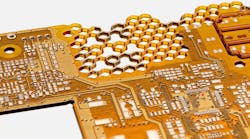By John Keller
SCOTTSDALE, Ariz. - Computer scientists are on the verge of boosting VME backplane databus speeds to as fast as 1 gigabit per second, or to enable a larger number of backplane slots to function at the same speed without incurring any substantial cost penalty, officials of VITA, the open-standards organization in Scottsdale, Ariz., announced today.
Inventor Andrew Berding, creator of the VME 320 standard, has invented a way to create a backplane where driver signals are independent of their backplane slots to create more robust VME signals than ever before to speed backplane data throughput.
Berding’s idea is to create a VME backplane databus in which all slots function identically, which is distinct from previous generations of VME backplanes that suffered from having different slots act differently, Berding says.
Older generations of VME backplanes, which move data between 32 and 320 megabits per second, may have drivers in end slots that try to move loads similarly to a long, slow, heavily loaded, low impedance transmission line, resulting in data that arrives at the far end too late-after it has already been sampled by the receiver, Berding says.
Likewise, a driver in a center slot attempts to drive a load that acts like two heavily loaded transmission lines in parallel. As a consequence, the driver may not have enough ability to drive a signal of sufficient amplitude to be received unambiguously somewhere between a guaranteed “1” or a “0.” Either case results in an unreliable system, Berding says.
Current backplanes, he says, stitch the copper traces from slot 1 to 2 to 3 to 4 and so on until the last slot. One exception to this is the star-wired backplane where all slots have a separate trace that connects near the center slot. Rather than acting as transmission lines, Berding says, it tends to act more like a lumped capacitance. There is still some variation in waveforms depending on which slot the driver is located, but the variations are minor.
Berding’s new VME backplane databus uses an unconventional wiring pattern to connect all odd-numbered and even-numbered physical slots together with traces. Slots 1 and 2 are connected together and the last and the next-to-the-last slots are connected together forming a continuous loop.
Physically the slots are in a straight line, but electrically all the drivers and receivers are in a circle with slots spaced evenly around the circle; a driver in any slot sees the same loading, Berding says.
Signals will arrive at the last load much faster than a previous-generation backplane, which enables systems designers either to operate the backplane faster or move more loads at the same speed.
The second option might be attractive for a VME backplane that now is limited to 21 slots in a 19-inch relay rack, Berding says. A telecommunications-standard 24-inch relay rack has room to place 27 slots. Computer simulations show that a 27-slot backplane made with this invention is still faster than a 21-slot previous-generation backplane.
For more information contact VITA online at www.vita.com.


